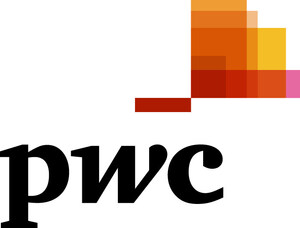NEW YORK, March 21, 2011 /PRNewswire/ -- With signs of a strengthening U.S. economy evident in declining initial jobless claims, rising business and consumer confidence, and growing employment figures, the PwC Real Estate Barometer, a new feature in the just-released first quarter 2011 PwC Real Estate Investor Survey, indicates that the fundamentals of the commercial real estate industry are slowly improving and supports the consensus among surveyed investors that the industry is moving past the bottom of the cycle.
(Logo: http://photos.prnewswire.com/prnh/20100917/NY66894LOGO)
The barometer tracks the anticipated performances of the four main property sectors (office, retail, industrial, and multifamily) from 2011 to 2014. By analyzing historical and forecast stock data, the barometer measures how the inventory of each sector changes over time in relation to the four stages of the real estate cycle – contraction, expansion, recession, and recovery. In addition, barometer analyses are prepared for various geographic regions and specific metro areas.
"Surveyed investors sense that the commercial real estate industry is moving past the bottom of the cycle, but the speed at which the U.S. economy is improving fundamentals has been slow and uneven at best," said Mitch Roschelle, partner, U.S. real estate advisory practice leader, PwC. "However, as investors become more confident about the long-awaited recovery of the industry, they are eager to get deals done. This bodes well for the industry as the volume of capital chasing deals is expected to increase in all sectors as investors work to deploy capital before interest rates rise, overall cap rates increase, and the industry shifts more in favor of sellers."
According to the barometer, the majority of office stock will be in recovery by year-end 2011 due to a lack of new supply and signs of decreasing vacancy for the U.S. office market. Even though job creation remains a concern, recovery is on the horizon with 86.2 percent of the U.S. office sector out of the market bottom by year-end 2012. In contrast, individual office markets that are expected to remain in recession through 2012 include Chicago, Las Vegas, Los Angeles, and Tampa.
For the retail market, inconsistent consumer spending and inflationary fears will keep the majority of retail stock (76.6 percent) in recession through 2012. A recovery will materialize by year-end 2013, with 77.1 percent of retail inventory in that phase. Individual retail markets that are expected to perform better than this sector as a whole include Long Island, Nashville, and Fairfield County, which are each expected to be in recovery through 2012.
Availability rates for the U.S. industrial sector are expected to peak in 2011 as tenant demand strengthens on the heels of a growing economy. As a result, the bulk of industrial stock will be in recovery in 2011 and 2012 (71.8 and 86.2 percent, respectively). As imports and exports increase, a larger portion of industrial stock will enter the expansion phase in 2013 and 2014 (20.9 and 40.6 percent, respectively). Individual industrial markets that are expected to lag this sector as a whole include Tampa, Akron, Cleveland, and Minneapolis.
The U.S. multifamily sector is well ahead of the other three sectors in terms of recovery. As tighter lending restrictions limit home-buying opportunities, pent-up housing demand will enlarge the portion of multifamily stock in the expansion phase through 2014, when it hits 30.2 percent. Two multifamily markets that are not expected to enter the expansion phase over the near term include New Orleans (in recovery through 2014) and Syracuse (in recession through 2014).
Lower Overall Cap Rates
The report finds that the average overall capitalization (cap) rate, a reflection of an investment's anticipated ownership risk, decreased in 27 of the 31 surveyed markets as signs of recovery become more apparent for both the economy and the industry. The highest quarterly decreases occurred in the regional apartment markets, where average cap rates compressed between 39 and 73 basis points this quarter.
Although an increasing number of investors are expanding acquisition searches to include secondary markets and "impaired" assets, cap rate compression continues to mainly occur for better-positioned and well-located assets that exhibit stable rent rolls and limited near-term leasing risk. Looking ahead, strong buyer interest, combined with more fluid debt markets, is recognized in investors' expectations that overall cap rates will either hold steady or decline over the next six months. Most Survey participants expect overall cap rates to hold steady in 25 of the Survey's 31 markets over the next six months.
"This year is a pivotal one for the industry, as 2011 began on the right foot with a string of positive news, giving investors the feeling that the recovery is real," stated Susan Smith, editor-in-chief of PwC's quarterly survey. "That said, there remain concerns among surveyed participants, such as rising oil prices, a still-shaky residential housing sector, and upcoming debt maturities. Despite these challenges, many investors remain focused on acquiring assets in anticipation of a continued recovery. Strong competition among buyers and the low-interest-rate environment continue to push overall cap rates lower for nearly all of the Survey's markets."
Information about subscribing to the PwC Real Estate Investor Survey can be found at www.pwc.com/us/realestatesurvey. Members of the media can obtain an electronic copy of the full report by contacting Scott Cianciulli at (212) 986-6667 or [email protected].
About the PwC Real Estate Investor Survey™
The PwC Real Estate Investor Survey, now in its 24th year of publication, is one of the industry's longest continuously produced quarterly surveys. The current report provides overviews of 31 separate markets, including ten national markets -- regional mall, power center, strip shopping center, CBD office, suburban office, flex/R&D, warehouse, apartment, net lease, and medical office buildings. The report also includes a review of 18 major U.S. office markets including Atlanta, Boston, Charlotte, Chicago, Dallas, Denver, Houston, Los Angeles, Manhattan, Northern Virginia, Pacific Northwest, Philadelphia, Phoenix, San Diego, San Francisco, Southeast Florida, Suburban Maryland, and Washington, DC. In addition, the report covers three regional apartment markets - - Mid-Atlantic, Pacific, and Southeast.
The first quarter 2011 report also features up-to-date information relating to valuation issues in the industry, such as replacement reserves, property management fees, leasing commissions, and concessions. In addition, each issue of the Survey contains over ten tables of market data focusing on value expectations, tenant improvement allowances, forecast periods, structural vacancy, and growth rates. Also in this issue is the semiannual National Lodging Highlights with analyses of four lodging segments.
About PwC
PwC (www.pwc.com) provides industry-focused assurance, tax and advisory services to build public trust and enhance value for its clients and their stakeholders. More than 163,000 people in 151 countries across our network share their thinking, experience and solutions to develop fresh perspectives and practical advice.
© 2011 PwC. All rights reserved. In this document, "PwC" refers to PricewaterhouseCoopers LLP, a Delaware limited liability partnership, which is a member firm of PricewaterhouseCoopers International Limited, each member firm of which is a separate legal entity.
SOURCE PwC
WANT YOUR COMPANY'S NEWS FEATURED ON PRNEWSWIRE.COM?
Newsrooms &
Influencers
Digital Media
Outlets
Journalists
Opted In





Share this article